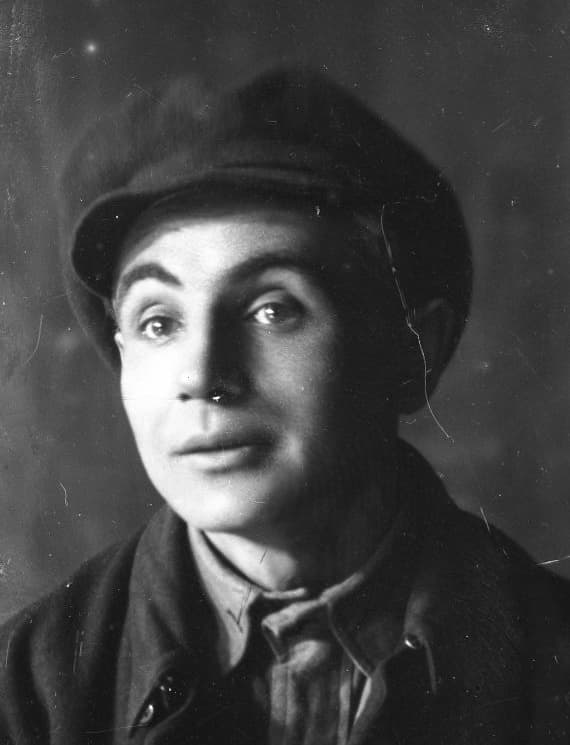April 9, 1900 – May 19, 1984
Ukrainian theater and cinema actress, pedagogue, author of articles on acting. People’s Artist of the Ukrainian SSR and Uzbek SSR (1943). Wife and student of the innovative theater and cinema director Les Kurbas.
She was born in St. Petersburg to the family of opera singer and Bolshoi Theater soloist Mykola Chystiakov, and spent her childhood and youth in the creative atmosphere of Moscow. Her father’s artistic and theatrical circles promoted the development of her artistry. Valentyna studied singing, dancing, drawing, playing the piano and took part in school performances.
In 1918 her family moved to Kyiv to get away from the Bolshevik chaos in Moscow. Valentyna joins the ballet studio of Anna Pavlova’s partner Mykhailo Mordkin and later takes movement and choreography lessons from Bronislava Nizhynska – Serzh Lyfar’s first teacher. She met Les Kurbas at the Bourgogne Theater (today the Lesia Ukrainka National Academic Theater of Russian Drama), where Mordkin had his studio and the Young Theater held rehearsals. Valentyna recalled this period in her life: “Meeting Oleksandr Stepanovych Kurbas in Kyiv in 1918 was the main event in my life. This meeting decided my fate – my personal and creative life. Could it have happened any other way? There was no way that Oleksandr Stepanovych – a brilliantly innovative director, with his erudition, exceptional work ethic, amazing talent and, at the same time, his sense of principle and purpose, not to mention his extraordinary good looks – could not have captivated me, a recent high school student from Moscow who had dreamed about a life in art since childhood. They married in St. Andrew’s Church in Kyiv on September 19, 1919.
Valentyna Chystiakova began her stage career with the Young Theater, where she made her debt as one of the chorus members in Sophocles’ Oedipus Rex. The actress created unforgettable images for each of her roles at the Young Theater (1919-1920), Taras Shevchenko First State Theater (1920), and Kyidramte touring theater (Bila Tserkva – Uman, 1920-1922). Mykola Bazhan wrote the following about the Kurbas theater’s arrival in Bila Tserkva and Uman and the actors, in particular Chystiakova: “The arrival of Kurbas’s theater was a turning point in my life. I was so fascinated by everything, every detail, every actuality, every burst of emotions and thoughts about theatrical performances that I did not miss a single one. But Valentyna Chystiakova’s unique musicality, elegance, beauty, artistry and talent made my heart, throat and breathing spasm. Having lived sixty long and difficult years after those experiences of youth, I feel that I have never since experienced such a passion for art and beauty. When I close my eyes I can see her as the charming Mirandolina, the sad Oksana, the tragic Kateryna, the broken Yevheniia, and more and more… Valentyna Mykolaivna, you brought so much good, light and beauty to people like me. I know your great importance to the history of Ukrainian theater, I know your great importance to the history of the human soul…”
Starting in 1922 Valentyna Chystiakova was one of the leading actresses of the Berezil Artistic Association in Kyiv. Kurbas’s directing brings out her multifaceted talent as a comedic, melodramatic, and deeply psychological actress. She plays leading roles such as the billionaire’s daughter (Georg Kaiser’s Gas (1923)), Oksana (Taras Shevchenko’s Haidamaky (1924)), Isabella (Prosper Mérimée’s The Jacquerie (1925)), among others.
Valentyna Chystiakova makes her cinematic debut in 1924 in the film Arsenaltsi (worker Vira disguised as a young lady) at the Odesa Film Studio, under the direction of her teacher and film director Les Kurbas.
In 1926 she moved to Kharkiv with the Berezil Theater and lived with her family in the Slovo House. Her roles included Dora (Oleksandr Popovskyi’s Prologue (1927)), Liubunia (Mykola Kulish’s The People’s Malakhii (1928)), Parania (Ivan Mykytenko’s Dictatorship (1930)), and Anelia (Mykola Kulish’s Maklena Grasa (1933)), a performance that everyone who attended the premier wouldn’t forget. Unfortunately, this was Les Kurbas’s last production as a free man. Valentyna Chystiakova was deeply affected by her husband’s dismissal from Berezil, his being stripped of the title of People’s Artist of the Ukrainian SSR, his arrest (December 25, 1933) and the destruction of the theater in 1933. She stood in line to send him care packages and books. Kurbas organized some ten performances at the Solovki prison camp. She hoped and waited for his return…
She spent her mature creative life with Les Kurbas’s mother Vanda (both women were “family members of an enemy of the people”) and found the strength to remain in her husband’s theater (then the Shevchenko Kharkiv Ukrainian Drama Theater) and appear on stage (1935-1959). The roles she played during this period were some of the best in Ukrainian theater. They included: Lida (Oleksandr Korniichuk’s Platon Krechet (1935)), Odarka (Marko Kropyvnytskyi’s Give the Heart Freedom and It Will Lead You into Slavery (1936)), Kateryna (Alexander Ostrovsky’s The Storm (1938)), Cesarina (Alexandre Dumas fils The Wife of Claude (1938)), Yevheniia (Honoré de Balzac’s Eugénie Grandet (1940)), Luchytska (Mykhailo Starytskyi’s Destiny (1941)), Lady Milford (Friedrich Schiller’s Love and Intrigue (1948)), Sofia Kovalevskaya (Tur Brothers’ Sofia Kovalevskaya (1948)).
In 1935 Valentyna Chystiakova returns to cinema at the insistence of innovative director Ivan Kavaleridze to star in his film Prometheus (inspired by the life of Taras Shevchenko) shot at Ukrainfilm (Kyiv, Odesa, 1935). With little material to work with, Chystiakova managed to create a multifaceted image of Dunka – merchant Zhukov’s ex-lover who is sold to a brothel. According to O. Mysiienko, the brilliant actress of the Kurbas school managed to create an unforgettable image and convey the character of the heroine, whose soul “was still burning with love for her insidious lover and whose heart was filled with hatred and contempt.” Chystiakova was one of the leading actresses at Berezil, for reasons likely beyond her acting skills. The unnatural suffering that could be read in her eyes couldn’t be acted. The couple’s situation was especially dramatic at the time. The brilliant Ukrainian director Kurbas had already been arrested and many of his students and actors at Berezil had renounced their mentor.
In 1941-1943 Valentyna Chystiakova and the theater were in Uzbekistan, where they performed in Levko (Kyiv Film Studio, 1942).
The thorny path to the truth proved to be endless. On June 29, 1955, she wrote to the Prosecutor General of the Soviet Union Roman Rudenko: “Due to the fact that for more than 18 years I have had no information about the fate of my husband, Oleksandr Stepanovych Kurbas, who was sentenced in 1934 to 5 years in the camps, I ask that you review the materials in his case and inform me of his whereabouts, whether he is alive, and your opinion on the possibility of his rehabilitation.”
According to the report of the Arkhangelsk Oblast KGB Investigative Division of April 29, 1956, Chief of the Arkhangelsk Oblast KGB Investigation Department Captain Chernyshov reviewed archival case #3363 regarding Oleksandr Stepanovych Kurbas (decision of the Special Troika of the Leningrad Oblast UNKVD of October 9, 1937 (minutes of Troika meeting #83) for continuing to hold counter-revolutionary positions and conducting counter-revolutionary agitation and showing terrorist intentions was shot on November 3, 1937”) and “would consider the decision of the Special Troika of the Leningrad oblast UNKVD against Oleksandr Stepanovych Kurbas to be abolished due to the lack of corpus delicti in the actions attributed to him.”
Valentyna Chystiakova didn’t receive a certificate from the Kharkiv Oblast Court until 1957. “The case against Oleksandr Stepanovych Kurbas was reviewed by the Presidium of the Kharkiv Oblast Court on April 19, 1957. The decision of the Judicial Troika at the Board of the GPU of the Soviet Union of April 9, 1934 concerning O.S. Kurbas was annulled due to the lack of corpus delicti.” Four years later she received notice that her husband “O.S. Kurbas died on November 15, 1942 at the age of 55 from a brain hemorrhage.” She figured it was a lie, but she couldn’t change or prove anything. Towards the end of her life, Valentyna Chystiakova wrote: “It is difficult for me to write and talk about Les Stepanovych. I will never be able to forgive and comprehend what happened. If I were to write about everything honestly, I would have cursed the Soviet government. But such memories are not published…” She wrote many articles on acting and memories about Berezil and Les Kurbas (published in 1991-1992 after her death). The place where Les Kurbas was shot became known in July 1997. Case #3168 (R. Skaliy) on charges against O.S. Kurbas was discovered, the Solovki “execution” lists were found, and dozens of documents and testimonies were published.
The memory of Les Kurbas is honored in Ukraine and abroad.


